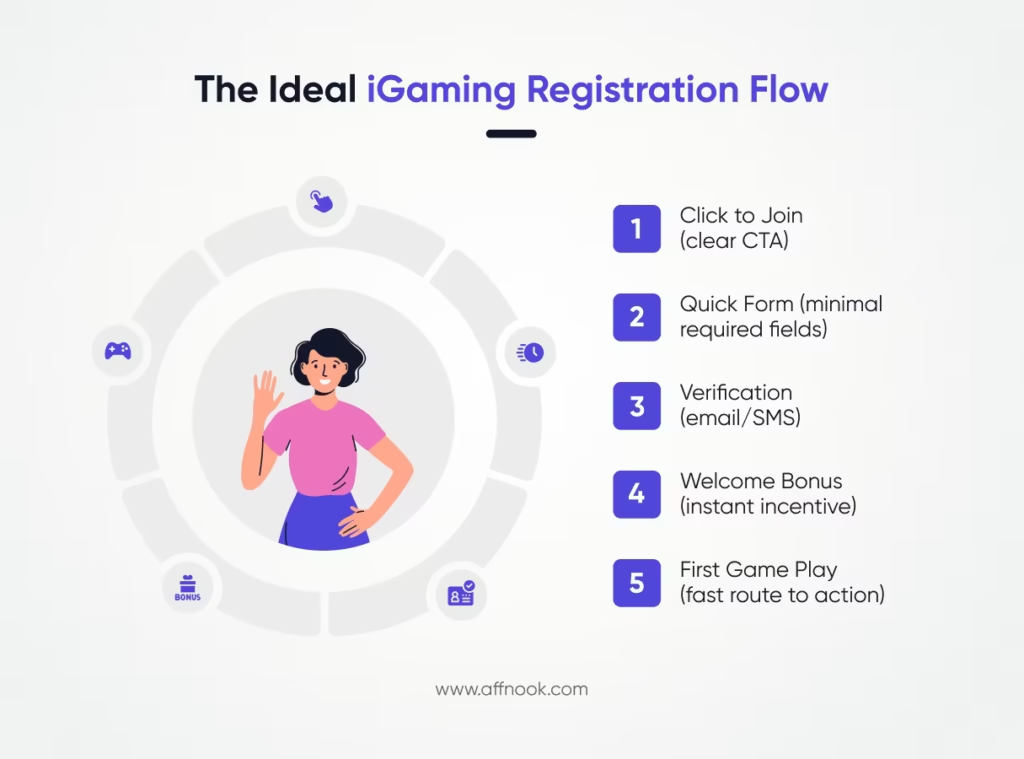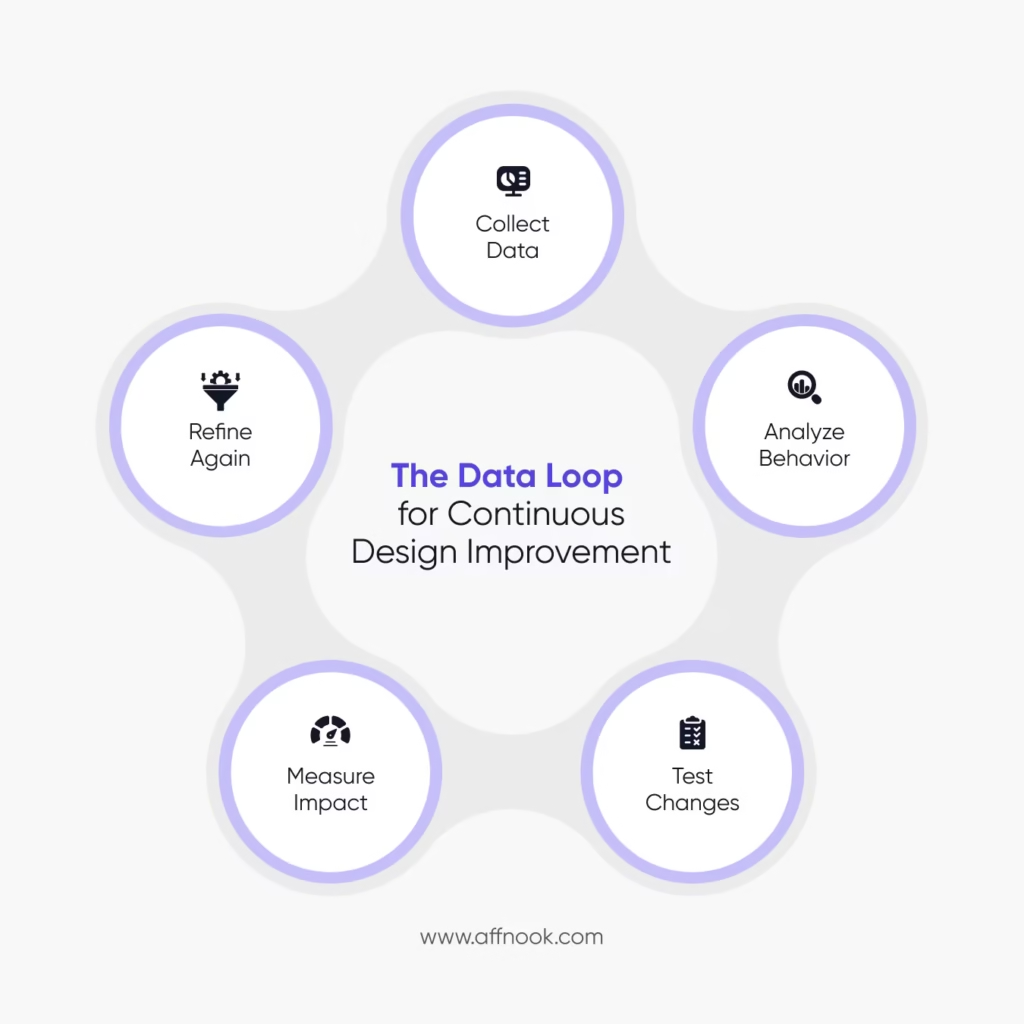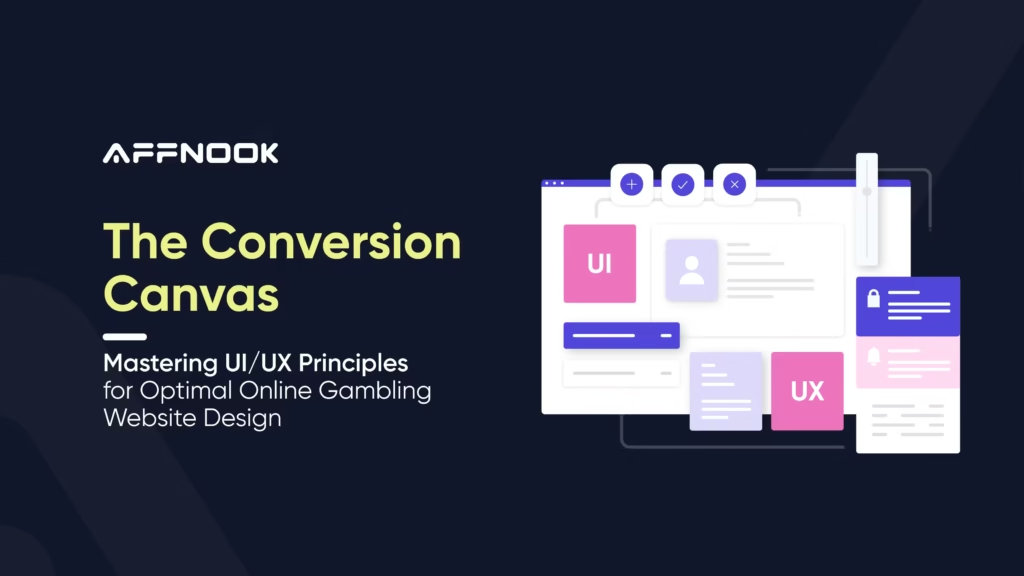In the modern, hyper-enthusiastic online gambling industry, gaining the interest of players is one thing, but retaining them and motivating them to take meaningful action is another.
User attention spans are razor-thin, with hundreds of platforms offering similar games and promotions. An ugly interface, confusing structure, or a friction-filled experience can push a player to a rival.
Investing in user-centered design is a competitive strength for an iGaming brand.
An interface that is well developed fosters a trusting relationship, low bounce rates, and likely returns. It brings improvements to all touchpoints in the player journey and turns passive clicks into active conversions.
That is why UI/UX is no longer a cosmetic factor but a strategic leverage for growth. Your online gambling website design has a direct influence on key business performance indicators—sign-ups, deposits, session time, and lifetime value.
Moreover, excellent design has nothing to do with cool animations—it is all about the ease of use, sleek onboarding, visual effects that will push the player through the next logical motion, be that registration, depositing, or spinning the reels.
The bottom line is that your platform’s success does not depend solely on the volume of games or bonuses that your platform offers—it also depends on the ease of access for a user. UI/UX is the silent mode that fuels any strategy to victory.
Understanding the User Mindset
You must first comprehend the psychology of the player to create an online gambling experience that converts. The user experience usually starts with an interest-initiated click, commonly an advertisement or affiliate link, which results in the home page or landing page.
Then, the user will navigate through games, evaluate bonuses, and, based on the developed trust, will proceed to registration and top-up. What do operators want to achieve? Reduce friction in each step.
Users come with a correlation of emotions: curiosity towards the platform, excitement about getting a win, time-limited promptness due to offers, and thinking, particularly about security and the legality of payouts. Your online gambling website design must preempt and react to these feelings with predictive hints, uncluttered flow, and speedy responsiveness.
Psychologically, three essential drivers are triggered by gambling that is:
- instant gratification (prize is obtained instantly after spinning a slot),
- reward anticipation (progression bar, bonus reveals create a sense of reward), and
- friction aversion (anything that can potentially slow them down causes doubt).
A clunky interface, slow loading, or a CTA that is difficult to find brings hesitation, and hesitation brings the drop-offs.
It is here that good UX design comes in. When you smooth the path of the players and make fewer choices necessary to take action, you enable ease and flow. One-click registration, dynamically updated game previews, and even sticky navigation can help to alleviate bounce and churn tremendously.
Core UI/UX Principles that Maximize Conversions
Although eye-catching images can draw attention, the fundamentals of UX are what makes the difference when it comes to the performance of online gambling website design. Major brands and operators who want higher conversions should think beyond aesthetics—into the psychology of a frictionless encounter.
Clarity and Simplicity
There can be no ambiguity or complexity. Players do not go to your platform to make complicated decisions. An untidy homepage having many options or overloaded designs results in mental exhaustion. Simplifying menus, bricking like-content, and consistent labelling will all translate to decisive action by the user—faster.
Consistency
Familiarity and trust are formed by consistency. It could be typography, iconography, or the color scheme, but the consistency of visual details across pages limits confusion. As the navigational patterns are consistent, all the buttons work as they should, and players smoothly navigate the site (with no second-guessing).
Responsive Design
Responsive design is essential as most users are on mobile. Mobile-first thinking keeps the functionality of layouts intact if a smaller screen is used. There should be thumb-friendly buttons, reasonable load rates, and compressible but accessible menus.
Feedback Loops
Feedback loops, such as spinners during game loading, a slight hover effect, or deposit confirmation, help users feel in control. These micro-interactions convey the message that the site is not out to frustrate them.
Micro-Interactions
Even minor micro-interventions, such as animations when opening a bonus or confetti after victory, create joy, improving the emotional level. They establish engagement hooks to increase satisfaction and retention.

Intuitive Navigation: Leading Users to the Jackpot
Although it may be just good-looking, a good online gambling website design will take users through the steps of interest and conversion. The one that holds the whole experience is navigation. When they cannot locate what they seek in a few seconds, then you have lost them.
A logical site architecture is essential.
- Popularize the content and structure the groups in such a way as to reflect the intention of the user, including new games, best slots, live casino, bonuses, and payment methods. A homepage is not intended to be a maze but a launchpad.
- Regarding menu design, horizontal menus are effective with desktops, as they provide visibility without overload. Mobile interfaces typically work better with vertical menus, which are sometimes concealed by hamburger icons. Consistency is important, regardless of layout.
- Sticky headers mean that any essential action is always not far away, such as logging in, depositing, or going back to the game lobby. Breadcrumbs enhance orientation, particularly within the multi-layered categories of games. And a forecasting search field? A must. It should take the users no more than three keystrokes to locate their favorite game.
- Each additional click is a risk. Reduce the clicks to get access to games, to claim bonuses, or to make a deposit. The objective—eliminate friction and establish a course of least resistance.
Crafting Compelling Call-to-Actions (CTAs)
Action is the key to online gambling—and great CTAs are the spark that ignites it. It can be registering, putting money in, or spinning the reels: the players must know exactly what the next step is, and be pushed to take it. This is where acute CTA design is crucial as a component of a successful online gambling website design.
Begin with language. Effective CTAs make use of action-oriented copywriting phrases that appeal to short-term value: “Spin Now”, “Claim Bonus”, “Deposit and Play”. Such cues provoke feelings of momentum, enhanced by the excitement users already have.
The location of the buttons is equally important. To drive the best conversion rates, place CTAs at the top of the fold on the landing page, close to decision points (bonus offers), and repeat them in strategic positions as the user scrolls through. Eye-tracking research on users indicates that they tend to shift to the right and central screen—make that screen property work.
There is also a role of color psychology. Orange and red are warm colors that may create a sense of urgency, whereas green represents safety and advancement. Only ensure the button is prominent and does not interfere with your brand palette.
Finally, test everything. Test the wording, color, sizes, and placements of CTA by using an A/B test to reveal what can generate clicks. Tiny adjustments can provide significant shifts in conversion.
Streamlined Registration & Onboarding Experience
The world of online gambling business is a world where commitment to registration is the initial and, in many cases, the first sign of friction. One of the greatest factors that makes players leave the sign-up process incomplete is a slow, sluggish process.
To modern users, who have become short on time and attention, short-form registration can be advantageous compared to long, multistep procedures. Request the bare minimum at the very start—email, password, and country. After establishing trust, you can gather more information with progressive profiling at the time of onboarding or just before making withdrawals.
With that said, multistep forms can be effective when well-built. The perceived effort can be lowered by breaking the process down into small, focused sessions, with a well-defined progress bar. Add field validation in real time and auto-formatting to format entries (e.g., phone numbers, dates).
Use social logins (such as Google or Apple) to eliminate the friction for mobile users, although it should be coupled with a traditional email form of sign-up to provide flexibility on regulatory and KYC requirements.
Never underestimate the effectiveness of smart defaults and the autofill option to reduce typing. Adaptive forms, most notably mobile users, will enjoy those that are smart enough to adjust according to the behavior of their input.

Game Discoverability: The Heart of Player Retention
Players are only half the problem in a competitive iGaming market—the other half is retaining them by making it easy to find the right games. An effective online gambling website design makes sure that players waste less time searching and more time playing.
Begin with the intuitive classification. Review the games categorized by theme, vendor, volatility, and popularity, or even special features such as jackpots, bonus rounds, etc. This not only serves a variety of player preferences but also makes exploration feel natural.
User empowerment requires smart filters and predictive search. A player who wants to find a particular slot must find it in a few seconds, whereas others may wish to browse depending on mood or style.
Personalization goes a step ahead. Behavior-based algorithms that drive these sections, known as “Recommended for You”, ensure a highly personalized experience with the feeling of a personal curation, as opposed to a generic one. Such practice reflects the personalisation of the best streaming services—maintaining users as they will provide the content they want upon first visit.
Visual is also important. New release banners, moving effects of focus games, and live jackpots lists can arouse interest and generate clicks.
Visual Hierarchy & Trust-Building Elements
First impressions are everything in iGaming. Visitors determine in seconds whether they will continue exploring or bounce—and an online gambling website design must rely on visual hierarchy to usher visitors instantly to value.
Above the fold, hero sections must feature the strongest incentives to remain—welcome bonuses, trending games, or jackpots of incredible proportions. Such elements must be powerful to look at (although balanced so as not to clutter).
Excitement is equally important as trust. Put security badges, SSL encryption indicators, licensing seals, and responsible gambling commitments prominently. These will assure newcomers that your platform is legit and secure. In high-value conversions such as deposits, the presence of evident trust indicators can be the difference between conversion and abandonment.
Whitespace, typography, and contrast are also used to create effective visual hierarchy. The strategic spacing catches attention to essential CTAs, and the styles of fonts and color can accent them to reach the button naturally.
Lastly, make use of social evidence to gain credibility and steam. Present recent winners, show live players’ screen pop-ups, or player testimonials. These signals appeal to the herd effect, with users now feeling less awkward about becoming a member.
Mobile UX Optimization: Where Most Players Are
As most of the iGaming traffic is currently using smartphones, a mobile-first online gambling website design is no longer a choice—it is a survival necessity. This means that the same users want to receive the same seamless experience on their phone that they do on the desktop, although with interfaces and features customized to smaller screens and mobile usage.
The priority is thumb-friendly navigation. This means:
- Buttons must be tap-friendly and resist misclicks, menus must be foldable but very fast to open, and galleries must be through with a simple swipe.
- The layout needs to be able to be used with one hand, so critical actions, such as a deposit or going back to the lobby, can be reached at any time.
Speed is not negotiable. Mobile users are notoriously impatient—sluggish load times or slow animations will drive them directly to competitors. Asset optimization, image compression, and adaptive loading help deliver the performance of lightning on devices and networks.
Stay out of intrusive popups or screens that are too busy with minimal real estate. Rather, focus on the key information, and provide details in droppable elements. Game previews, bonuses, and CTAs must be visible, but the interface must not be clustered.
Data-Driven Design: Leveraging Analytics to Iterate
Guessing is very costly in iGaming, and data is your best design companion. Assumptions should be abandoned in modern online gambling website design because it has to be driven by measurable user behavior. Heatmaps visualize clicks, hovers, and abandon, and psychological monitoring tells you how far down a page a player goes.
Funnel analytics can identify friction points that might be a registration step that drives people away, or a bonus banner that does not convert. A/B testing of the layouts, CTAs, colors, and navigation patterns is a habit that promotes constant improvement.
By bringing analytics and UX best practices together, operators have the ability to better understand and execute modest improvement efforts that add up to dramatic conversion and customer retention increases.

Conclusion
The iGaming industry is generous to the platforms that realize one simple truth—the players come to where it feels stress-free, exhilarating, and confidence-inspiring. Online gambling website design is not just window dressing—it is a conversion machine. Each component, including navigation, CTAs, mobile optimization, and so forth, contributes to the smooth transition of user entry to action.
The benefit of the design investment is clear to brands and operators. Simplified flows minimize bounces. Personalization will make the players stay curious. Deposits are boosted by trust signals. And mobile-first design will make it accessible wherever your audience plays. This is not about following trends—it is about having a flexible player-centric infrastructure that is able to adapt to market demands and user behavior.
Affiliates can also benefit when they emphasize quality design. Greater UX results in greater landing page engagement, increased click-through to partner casinos, and eventually more funnel conversions.
The potential is in viewing design not as a project, but as a continuous, quantitatively informed approach. Keep testing. Keep iterating. Continue matching the visual experience of the players to the emotional experience.
When every millisecond may cost you or gain you a customer, the more conversion-minded and seamless planning of the environment of brands will get a repeat visit, where the players are concerned. It is not just all the games and the jackpot, is the experience you create.
Help Section
1. What are the best UI/UX practices for increasing player engagement in online gambling website design?
The best practices include intuitive navigation, fast-loading interfaces, mobile-first layouts, personalized game recommendations, and engaging visuals. These elements keep players engaged, reduce bounce rates, and guide them seamlessly toward desired actions like registration or deposits.
2. How can intuitive navigation improve conversion rates on an online gambling website?
Intuitive navigation ensures players find games, promotions, and account features quickly. A well-structured menu, logical categorization, and persistent navigation bars reduce friction, creating a smoother user journey that directly improves conversion rates and session duration.
3. What role does mobile-first design play in the success of an online gambling platform?
Mobile-first design ensures your online gambling website performs flawlessly on smartphones, where most players engage. Optimizing touch interactions, load times, and responsive layouts boosts accessibility, retention, and deposits across both casual and high-value players.
4. How can clear CTAs and visual hierarchy boost sign-ups on an iGaming website?
Clear CTAs stand out visually, guiding users toward actions like “Join Now” or “Play Instantly.” Combined with a strong visual hierarchy, they remove decision fatigue and help maximize sign-up completions in online gambling website design.
5. What features should be included in the registration process for optimal online gambling website design?
Keep registration short with essential fields, real-time validation, and social logins. Use progressive profiling for additional data later. This minimizes friction, meets compliance needs, and increases the likelihood of player sign-up completion.




